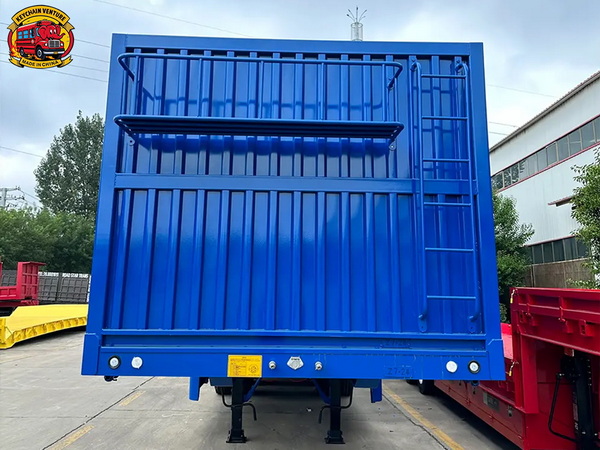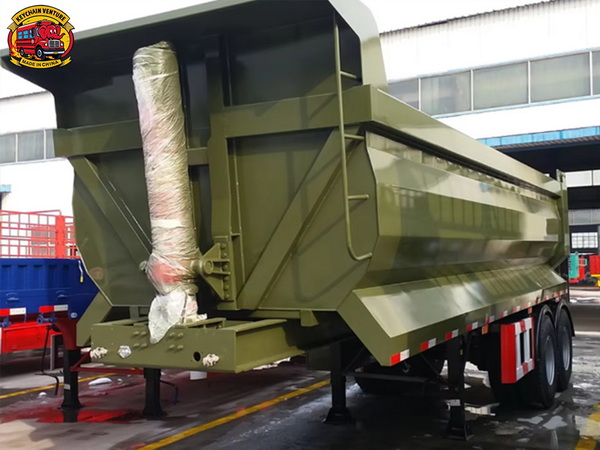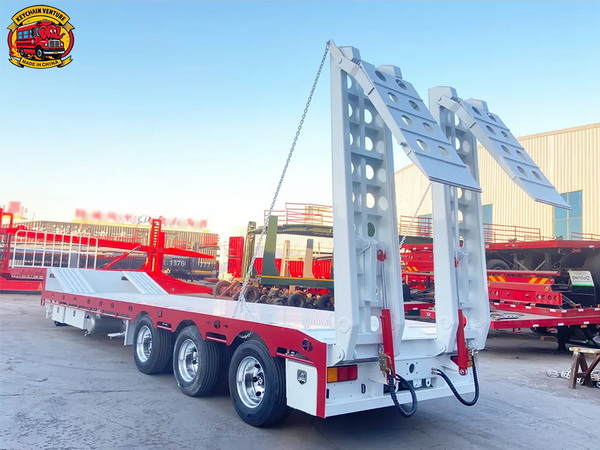Views: 222 Author: Amanda Publish Time: 2025-10-28 Origin: Site








Content Menu
● Standard Semi Trailer Lengths
● Why Does Trailer Length Matter?
● Factors Influencing Semi Trailer Length
>> Cargo Type and Loading Practices
● Technological Innovations in Semi Trailers
>> Electric and Autonomous Developments
● International Perspectives on Semi Trailer Length
● Real-World Applications and Case Studies
>> Logistics Companies: Maximizing Efficiency
>> Construction and Manufacturing
● Safety, Maneuverability, and Challenges
>> Turning Radius and Handling
● Semi Trailer Sustainability and the Future
● Practical Tips: Selecting the Right Semi Trailer Length
● The Importance of a Knowledgeable Supplier
● Summary Case Study: Fleet Modernization Success
● Frequently Asked Questions (FAQ)
>> 1. What is the standard semi trailer length in the USA?
>> 2. Are shorter semi trailers available?
>> 3. Can semi trailers be custom sized?
>> 4. How does trailer length affect load capacity?
>> 5. What happens if a semi trailer exceeds length regulations?
The semi trailer is a pillar of the modern transportation industry, moving everything from produce and electronics to raw materials across cities, countries, and continents. Fleet operators, logistics specialists, and regulatory agencies all depend on precisely defined semi trailer dimensions for efficiency, compliance, and cost savings. Whether your goal is to optimize fleet operations, make informed purchasing decisions, or simply understand the differences between markets, this article offers a comprehensive, detailed exploration of semi trailer lengths, enriched with practical insights and technical context.

A semi trailer is a type of freight carrier that attaches to a tractor unit or “cab,” forming what's commonly called a semi truck or articulated vehicle. Unlike a full trailer, a semi trailer doesn't have a front axle; its weight is partially supported by the tractor via a fifth-wheel coupling system. This configuration increases maneuverability, enables higher payloads, and provides modular flexibility for fleets transporting varied cargo loads.
The length of a semi trailer is one of the most critical specifications in logistics and fleet operation. It impacts cargo volume, route selection, regulatory compliance, and operating cost. Across North America, the standard length for most dry van and refrigerated semi trailers is 53 feet—an industry benchmark that balances capacity with legal road limits. However, lengths may vary:
- Dry van trailers: Usually 53 feet, but variants exist between 48–53 feet.
- Flatbeds: Commonly 48–53 feet, accommodating bulky or oversized freight.
- Tankers: 40–53 feet, sized dependent on liquid cargo and safety needs.
- Double or triple trailer combinations: Typically, each “pup” trailer is 28 feet long.
Globally, standards differ. In the EU, typical semi trailers measure about 44–52 feet; in China, common lengths range from 42–54 feet, reflecting local infrastructure and regulatory differences.
Longer semi trailers allow for larger payloads, which means more goods moved per transport cycle, directly reducing cost per shipment and environmental impact.
Understanding the legal length for semi trailers in your operating regions prevents fines, enhances safety, and streamlines planning. Authorities regulate trailer lengths to balance roadway safety, infrastructure durability, and traffic efficiency.
A 53-foot semi trailer works well for long highway routes, distribution centers, and warehouse docks but may be unwieldy in tight urban environments or rural lanes. Operators sometimes choose shorter trailers for delivery flexibility.
Trailer length is measured from the front wall (not including the cab) to the rear doors, omitting the kingpin and coupling equipment. All overhangs, bumpers, and extensions are added if local laws require. Accurate measurement is essential not only for compliance but also for effective cargo planning and load quoting.
Each region applies distinct laws governing semi trailer lengths:
- United States: Most states allow a maximum trailer length of 53 feet for a single trailer; double and triple configurations use shorter “pups”.
- European Union: Maximum standard cargo trailer is 13.6 meters (44.6 feet), with possibilities for “longer and heavier vehicles” on designated routes.
- China: Regulations permit several lengths (13m, 14m, 16.5m) to suit different markets and applications.
- Some cargo types (e.g., heavy machinery, bulk liquids) may not require a full-length trailer.
- Perishable goods benefit from extra room and temperature controls, leading to longer reefer trailers.
- Construction fleets prioritize maneuverability, opting for shorter flatbed trailers.
Research shows that fleet operators maximize revenue by matching semi trailer length, weight allowance, and specialized fitment (e.g. refrigerated units, tankers) to the specific needs of their logistics network.
Engineering advancements now allow for extendable trailers, where sections of the deck telescope to increase length for specialized loads. These semi trailers give operators flexibility across diverse freight profiles.
Sensors and analytics systems—collecting data on trailer length, load status, and conditions—improve fleet reliability, efficiency, and regulatory compliance. Smart semi trailers are increasingly adopted in modern transportation for real-time visibility and predictive maintenance.
The rise of electric semi trucks and autonomous driving technologies is reshaping the trailer industry. Battery placement can shift internal layouts, and self-driving systems may enable new legal standards for maximum length, route access, and safety features.

Global commerce depends increasingly on harmonized specifications. The following data highlight the diversity of standards:
- USA: Standard trailers at 53 feet with some older models at 48 feet.
- Canada: Adopts US norms for most transborder freight.
- EU: 44–52 feet, favoring narrower and shorter trailers for urban and intermodal flexibility.
- Australia: Up to 53 feet, but regulations vary by state.
- China: Wide spectrum—42 to 54 feet—reflecting rapid infrastructure evolution.
Differences in regulations originate from unique infrastructure challenges, population density, cargo types, and safety priorities across regions.
Leading logistics providers such as KeyChain Venture Co., Ltd. partner with operators to standardize trailer length according to optimal cargo configurations and route maps, balancing cost and efficiency.
53-foot refrigerated semi trailers dominate food transport from warehouses to grocery chains. The extra length helps consolidate loads, minimizing travel frequency while preserving perishables.
Shorter flatbeds (48 feet) offer greater flexibility for moving steel, pipes, or heavy equipment within restricted access sites.
Longer semi trailers mean a wider turning radius, making navigation of urban streets, roundabouts, and tight loading docks more demanding for drivers.
Warehouse managers plan for sufficient dock room and parking space to accommodate standard 53-foot semi trailers. Upgrades in software and planning tools help streamline this logistical hurdle.
Extra-long trailers require special permits, restricting their access to certain highways, travel times, and delivery points. Smart route planning ensures compliance and timely delivery.
With increased focus on environmental standards, manufacturers are optimizing trailer aerodynamics and weight to boost fuel efficiency and minimize emissions. Developing lightweight but durable trailers for electric and hybrid fleets is a top priority for global logistics companies.
Surging e-commerce and international freight are driving demand for high-capacity semi trailers. Innovations like modular trailer sections, telematics integration, and eco-friendly builds are shaping the next generation of road transportation.
1. Clarify Cargo and Route Needs: The starting point for every fleet operator is to align semi trailer length with typical payloads and route characteristics.
2. Review Regulatory Requirements: Always verify local road laws before purchase.
3. Consider Future Needs: Modular or extendable trailer solutions provide flexibility without risk of non-compliance.
4. Invest in Smart Trailers: Tracking systems and analytics improve fleet management and cost control over time.
5. Work with Trusted Partners: Companies like KeyChain Venture Co., Ltd. offer expertise in matching fleet solutions to dynamic market requirements.
Working with a reliable supplier ensures access to compliant, high-performance semi trailers tailored precisely to your logistics demands. Leading vendors provide deep regulatory expertise, advanced designs, and ongoing technical support for operators scaling domestically or internationally.
KeyChain Venture Co., Ltd. helped a fast-growing logistics company shift from a mixed trailer fleet (48-foot flatbeds, 53-foot dry vans) to exclusively 53-foot trailers. This conversion improved average shipment sizes, trimmed trip numbers, and reduced overall operating costs while keeping every load within legal requirements.
Understanding the length of a semi trailer in feet is fundamental to modern fleet management, regulatory compliance, and supply chain optimization. While the industry standard in North America is the 53-foot trailer, regional differences, cargo requirements, and technological advances continue to expand the landscape of trailer design and deployment. Businesses—from logistics giants to smaller fleets—benefit immensely from selecting the right trailer size, investing in new technologies, and partnering with expert suppliers to drive progress in transportation efficiency and safety.

Most trailers for general freight are 53 feet long, supporting the widest variety of cargo types and routes.
Yes. Double or triple configurations commonly use 28-foot pup trailers, preferred for regional and urban distribution.
Manufacturers can tailor lengths for specialized applications, such as bulk materials, oversized goods, or restricted delivery sites, provided all trailers remain within jurisdictional legal limits.
Longer trailers allow for greater volume, but legal maximum weights still apply, so load planning must balance size and total weight.
Operators must obtain special permits for oversized trailers and adhere to routed travel plans, hours of operation, and additional safety provisions.